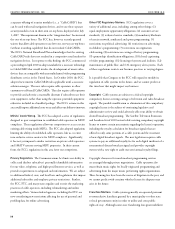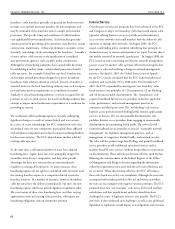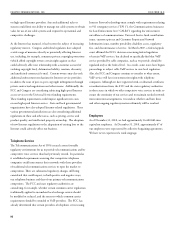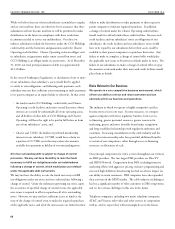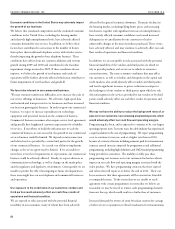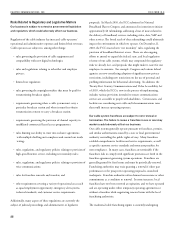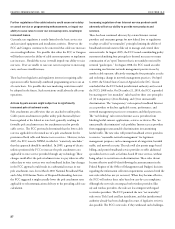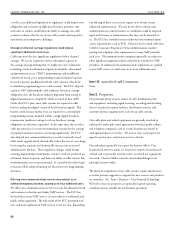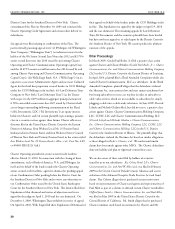Charter 2010 Annual Report Download - page 36
Download and view the complete annual report
Please find page 36 of the 2010 Charter annual report below. You can navigate through the pages in the report by either clicking on the pages listed below, or by using the keyword search tool below to find specific information within the annual report.
Malicious and abusive Internet practices could impair our high-
speed Internet services.
Our high-speed Internet customers utilize our network to access the
Internet and, as a consequence, we or they may become victim to
common malicious and abusive Internet activities, such as peer-
to-peer file sharing, unsolicited mass advertising (i.e., “spam”) and
dissemination of viruses, worms, and other destructive or disruptive
software. ese activities could have adverse consequences on
our network and our customers, including degradation of service,
excessive call volume to call centers, and damage to our or our
customers' equipment and data. Significant incidents could lead to
customer dissatisfaction and, ultimately, loss of customers or revenue,
in addition to increased costs to service our customers and protect
our network. Any significant loss of high-speed Internet customers
or revenue, or significant increase in costs of serving those customers,
could adversely affect our growth, financial condition and results of
operations.
For tax purposes, we experienced a deemed ownership change
upon emergence from Chapter 11 bankruptcy, resulting in an
annual limitation on our ability to use our existing tax loss
carryforwards. We could experience another deemed ownership
change in the future that could further limit our ability to use our
tax loss carryforwards.
As of December 31, 2010, we had approximately $6.9 billion of
federal tax net operating and capital loss carryforwards resulting
in a gross deferred tax asset of approximately $2.4 billion, expiring
in the years 2014 through 2030. ese losses resulted from the
operations of Charter Holdco and its subsidiaries. In addition, as of
December 31, 2010, we had state tax net operating and capital loss
carryforwards, resulting in a gross deferred tax asset (net of federal tax
benefit) of approximately $228 million, generally expiring in years
2011 through 2030. Due to uncertainties in projected future taxable
income, valuation allowances have been established against the gross
deferred tax assets for book accounting purposes, except for future
taxable income that will result from the reversal of existing temporary
differences for which deferred tax liabilities are recognized. Such tax
loss carryforwards can accumulate and be used to offset our future
taxable income.
e consummation of the Plan generated an “ownership change”
as defined in Section 382 of the Internal Revenue Code of 1986, as
amended (the “Code”). In general, an “ownership change” occurs
whenever the percentage of the stock of a corporation owned, directly
or indirectly, by “5-percent stockholders” (within the meaning of
Section 382 of the Code) increases by more than 50 percentage
points over the lowest percentage of the stock of such corporation
owned, directly or indirectly, by such “5-percent stockholders” at any
time over the preceding three years. As a result, Charter is subject
to an annual limitation on the use of our loss carryforwards which
existed at November 30, 2009. Further, our loss carryforwards have
been reduced by the amount of the cancellation of debt income
resulting from the Plan that was allocable to Charter. e limitation
on our ability to use our loss carryforwards, in conjunction with
the loss carryforward expiration provisions, could reduce our ability
to use a portion of our loss carryforwards to offset future taxable
income which could result in us being required to make material cash
tax payments. Our ability to make such income tax payments, if
any, will depend at such time on our liquidity or our ability to raise
additional capital, and/or on receipt of payments or distributions
from Charter Holdco and its subsidiaries.
If Charter were to experience a second ownership change in the
future (as a result of purchases and sales of stock by Charter’s 5-
percent stockholders, new issuances or redemptions of Charter’s
stock, certain acquisitions of Charter’s stock and issuances,
redemptions, sales or other dispositions or acquisitions of interests
in Charter’s 5-percent stockholders), Charter’s ability to use our loss
carryforwards could become subject to further limitations. Our
common stock is subject to certain transfer restrictions contained
in our amended and restated certificate of incorporation. ese
restrictions, which are designed to minimize the likelihood of an
ownership change occurring and thereby preserve our ability to
utilize our loss carryforwards, are not currently operative but could
become operative in the future if certain events occur and the
restrictions are imposed by Charter’s board of directors. However,
there can be no assurance that Charter’s board of directors would
choose to impose these restrictions or that such restrictions, if
imposed, would prevent an ownership change from occurring.
If we are unable to retain key employees, our ability to manage
our business could be adversely affected.
Our operational results have depended, and our future results
will depend, upon the retention and continued performance of
our management team. Over the last twelve months, we have
experienced significant changes in our management team and
may experience additional changes in the future. Our ability to
retain key employees for management positions could be impacted



